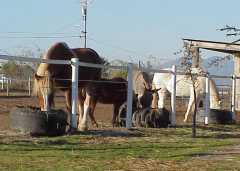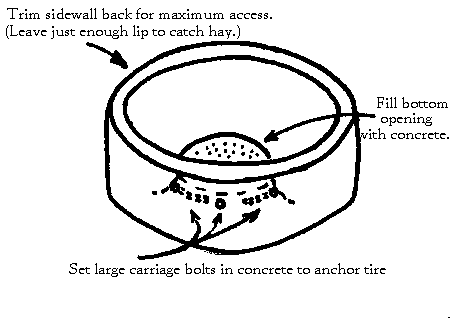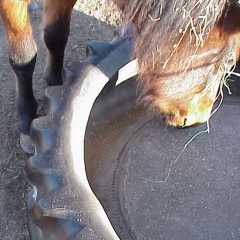Safe, Maintenance-free Feeders on a BudgetHorse Proof Feeders |

| |||
© 1995, Willis & Sharon Lamm
If horses haven't anything else to do, they will chew... so how do you set up to feed them, on a budget, in a manner which is both natural and practical and doesn't require constant maintenance? We have found that making feeders from old balloon tires allows our horses to eat naturally from the ground (stretching their toplines), keeps the hay from being spread all over, are easy to throw hay into, and (so far) are virtually indestructable.We get old balloon tires from local tire shops. (The shops are grateful to get rid of them.) We select tires which have a wide track so they are reasonably tall when lying on their sides and will keep hay from being pulled out. Here is how we make ours.

| ||||
|
It's is critically important to widen the opening on one side of the tire. Leaving the original "rim sized" opening on the side of the tire that the horse reaches through can trap a horse! We cut out about 2/3 of the sidewall on one side to increase the opening, leaving just enough sidewall overhanging the opening to help contain the hay when the horse pulls it up. We then set the tire on an old piece of plywood and prepare to fill the opposite opening with concrete. (We use the plywood as a form to ensure a flat surface on the bottom of the concrete so the tires can be moved around by the tractor when necessary.) Since the horses can sometimes pull the tires off the concrete bases, we drill 4 to 6 holes where we insert large, long carriage bolts which will become set in the concrete. We secure the bolts to the tires with nuts so they will stay snug while the concrete is being poured. With tires which have very flat side profiles, these bolts may have to be heated and bent. Once the concrete sets up, the tires are ready to use. With tires which are exposed to the elements, we take a small hole saw and saw a few drain holes so they don't turn into mosquito swimming pools. Also in some instances where overly boisterous horses have learned to drag the tires around, we have attached a U-bolt to the edge of the tire and attached it by a short cable to an appropriate fence post. |
Note the small "lip" that won't catch
heads and feet when the horse is
scrounging for those last morsels,
and concrete in the center so a hoof
can't get caught underneath the bead.
| |||
Press Back to return to the page which brought you hereReturn to KBR Quick Tips Index PageReturn to KBR Horse Health SectionGo to KBR Safety SectionGo To
| ||||

